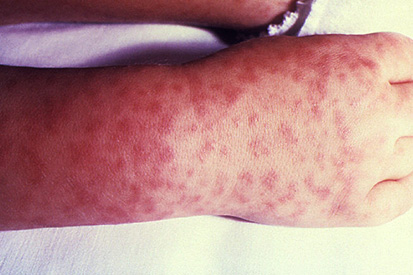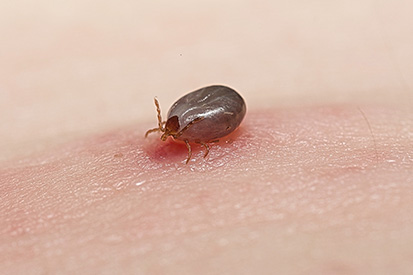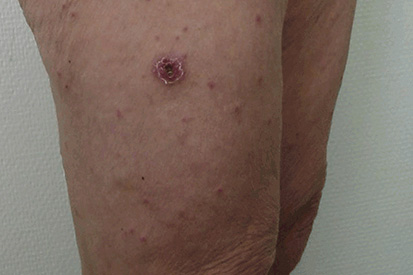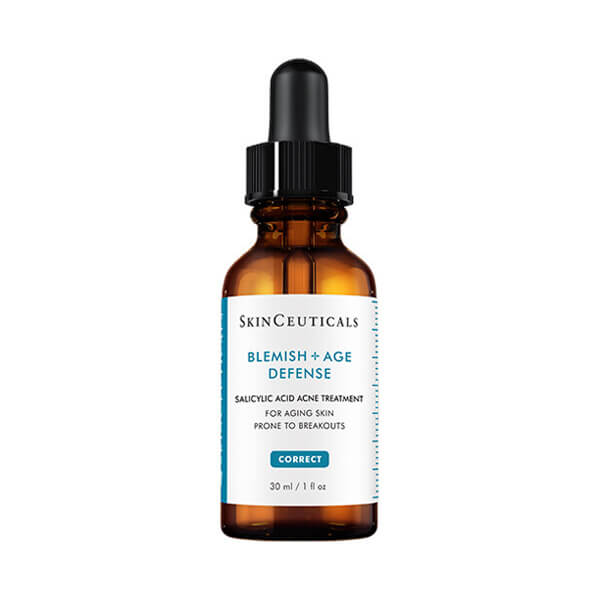Rocky Mountain Spotted Fever
At Lupton Dermatology, our experienced team is committed to providing comprehensive care, offering expert diagnosis and treatment options to ensure the health and safety of our patients faced with tick-borne illnesses like RMSF.
Examples of Rocky Mountain Spotted Fever



What are the Symptoms of Rocky Mountain Spotted Fever?
- Rocky Mountain Spotted Fever is characterized by a rash that begins as small red spots or blotches on the wrists, ankles, palms or soles of the feet. It spreads up the arms and legs to the trunk of the body. These symptoms take between one and two weeks to appear following a tick bite.
- The rash is often accompanied by fever, chills, muscle ache, red eyes, light sensitivity, excessive thirst, loss of appetite, diarrhea, nausea, vomiting and/or fatigue.
Causes of Rocky Mountain Spotted Fever
- Rocky Mountain Spotted Fever (RMSF) is primarily caused by the bacterium Rickettsia rickettsii. This bacterium is transmitted to humans through the bite of infected ticks, with certain species acting as vectors.
- Ticks such as the American dog tick, the Rocky Mountain wood tick, and the brown dog tick are common carriers of Rickettsia rickettsii.
- The life cycle of the bacterium involves ticks and certain mammals, such as rodents and dogs, serving as hosts.
- Humans become infected when bitten by an infected tick during any stage of its life cycle.
How to prevent Rocky Mountain Spotted Fever
Preventing Rocky Mountain Spotted Fever (RMSF) involves minimizing tick bite risks. Avoid grassy and wooded spots, choosing clear trails. Use EPA-approved tick repellents like DEET or picaridin on exposed skin and clothing and wear protective clothing, including long sleeves and pants.
Regular tick checks post-outdoor activities, focusing on hidden areas, are vital. Prompt and proper tick removal with fine-tipped tweezers is crucial. These measures significantly reduce RMSF risk, promoting well-being in tick-prone environments.
Rocky Mountain Spotted Fever (RMSF) FAQs
Rocky Mountain Spotted Fever is a bacterial infection caused by Rickettsia rickettsii. It is transmitted through the bite of an infected tick, most commonly the American dog tick, Rocky Mountain wood tick, and brown dog tick.
Symptoms usually appear 2-14 days after a tick bite and can include:
- High fever
- Severe headache
- Rash (typically starting at the wrists and ankles)
- Nausea and vomiting
- Muscle pain
- Lack of appetite
RMSF is a serious illness that can be fatal if not treated promptly. Early diagnosis and treatment with antibiotics are crucial to prevent severe complications or death.
Diagnosis is based on clinical signs and symptoms, and confirmed through specialized laboratory tests such as serology, PCR, or immunohistochemistry on a skin biopsy.
- Remove the tick as soon as possible using fine-tipped tweezers.
- Grasp the tick close to the skin and pull upward with steady, even pressure.
- Clean the bite area and your hands with rubbing alcohol, an iodine scrub, or soap and water.
- Monitor the area for signs of infection and seek medical attention if symptoms of RMSF develop.
How to treat Rocky Mountain Spotted Fever
The primary treatment for Rocky Mountain Spotted Fever (RMSF) involves prompt administration of antibiotics,
If RMSF is suspected, seeking prompt medical attention is essential. Schedule an appointment with us today for timely and effective care.
Early diagnosis and treatment significantly improve outcomes and reduce the risk of complications associated with Rocky Mountain Spotted Fever, especially for individuals bitten by ticks in endemic areas.
Featured Products for Acne

Bright Girl Gel Facial Cleanser
Bright+Clean Gel Facial Cleanser is a pH-balanced cleanser (pH= 5.5-6.5) is designed to work with your skin’s barrier while washing away dirt, sweat, and make-up. Bright+Clean cleanses and nourishes with a subtle natural fragrance that is designed to positively reinforce consistent use. 6.7 FL OZ (200 ML)

SkinCeuticals Blemish + Age Defense
Blemish + Age Defense is a targeted, oil-free approach for aging skin prone to breakouts. This first-to-market acid blend combines 2% dioic acid with an optimal alpha- and beta-hydroxy acid formulation to reduce the formation of acne and clogged pores. 1 fl oz / 30 mL
